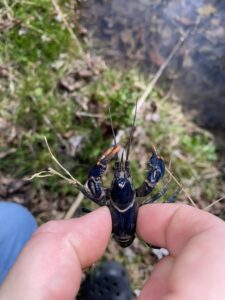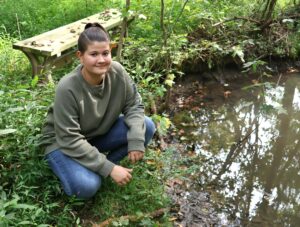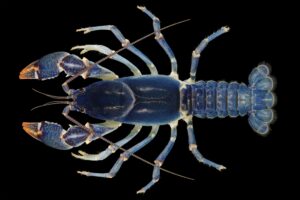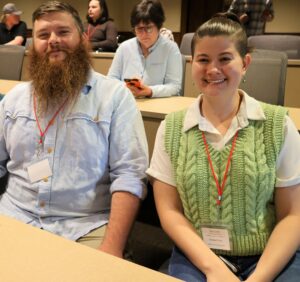GREENEVILLE – The Tennessee Wildlife Resources Agency is examining whether two Tusculum University students have discovered something special – a new crayfish species – on campus.

Tusculum student Breanna Mathes shows the spot where she and Joe Calloway captured the crayfish that was provided to the Tennessee Wildlife Resources Agency.
In the spring, students Joe Calloway and Breanna Mathes captured a blue crayfish in the Tusculum Nature Trail on campus. That set in motion a series of actions by the TWRA and, now, a detailed analysis that will determine whether Calloway and Mathes found something unique.
“In April, we surveyed that part of the campus and caught a good series of specimens,” said Carl Williams, a TWRA wildlife technician. “We molted them out, and they were pretty unique looking. They were definitely not what you would find on the Cumberland Plateau or in the Blue Ridge, so that gave us a suspicion these were probably something new. It’s fun to pick something up and think, ‘This could be the first time anyone has ever held this species in their hand.’”
The TWRA has collected tissues from the specimens on campus along with other crayfish populations in the state, all of which will eventually be sent to Yale University for DNA extraction and data analysis. Williams said the process will take two or three years to complete.
If this study concludes the crayfish found at Tusculum were indeed different, they would become the 96th species of this crustacean in Tennessee.
The story began when Calloway and Mathes were in the Nature Trail, not far from the Paul E. Hayden Educational Wetland, on Feb. 21 looking for frogs as part of a class assignment. This occurred just a few months before Calloway graduated from Tusculum with a bachelor’s degree in environmental science. Mathes, now a senior, is pursuing bachelor’s degrees in environmental science and biology.

Joe Calloway holds the first blue crayfish he and Breanna Mathes discovered.

Tusculum student Breanna Mathes crouches by the pond where she and Joe Calloway first discovered the blue crayfish.
When these students first saw the blue crayfish in the flood plain, it immediately piqued their interest because of its color. Neither had seen a blue one before. It also surprised Mathes because the size was larger than what she had previously seen in other crayfish at Tusculum. Plus, this crayfish was in a pond in the flood plain versus a creek, which is the usual body of water to locate other types of crayfish.
“It was very shocking to find that species out there considering we had no idea it was there or how long it was there,” Mathes said. “It was amazing to see how easy it was hiding under our noses and we didn’t even know it.”
The students captured the crayfish, took a photo of it and then released it back into the water.
Calloway, who had served as an intern in 2022 with a TWRA stream survey unit, knew the TWRA studied crayfish and that Williams would be interested in hearing about this discovery. He sent the photo to Williams, who was immediately intrigued.
Williams wanted to physically see that type of crayfish, so Calloway and Mathes returned to the same area the next day. They captured one outside the creek but not far away and then stored it in Tusculum’s environmental science lab. Williams came to campus to pick up the crayfish.
The students collected the first crayfish at 2:30 p.m. and the second one at about 4 p.m. That was another unexpected development.
“This was a burrowing crayfish, which is difficult to catch because it usually spends daylight hours underground,” Calloway said. “We were fortunate to be in the right spot to capture it when it came out so we could provide it to the TWRA.”
The discovery on the Tusculum campus was interesting because the TWRA had conducted crayfish sampling a couple of years ago on U.S. Forest Service property in the Paint Creek watershed of Greene County and saw a blue crayfish that looked different than what had previously been identified.
“What Joe and Breanna found looks similar to that but not exactly,” Williams said. “It could be just a little bit of variation between populations, or they could be two different things. That’s what was going through my mind – we’ve either expanded that population from the Paint Creek watershed to the Nolichucky system, or it could be something else that is unique to the Nolichucky system. It’s going to be exciting to see where it ends up.”

This is the crayfish that was discovered the second time on campus and was picked up by the TWRA.
Calloway, who is now working as a larval hatchery technician for Sustainable Aquatics in Jefferson County, is enthused about what he and Mathes found.
“East Tennessee is highly diverse in the number of fish and plant species, and I am happy that Breanna and I might have found another example,” Calloway said. “I am looking forward to seeing the results of the examination and will be pleased if Tusculum was the source of something distinct.”
Mathes, who is interning with the U.S. Forest Service, is excited about this development and will have a poster presentation about it this semester. She said Dr. Susan Monteleone, associate professor of biology, and Jordan Baker, assistant professor of biology, helped her and Calloway more fully recognize the importance of their discovery.
“I’m kind of in disbelief,” Mathes said. “It’s hard to believe that Joe and I were just casually looking for frogs one day and we stumbled on a potential new species.”
Williams said the layout and environment of the Tusculum campus with College Creek and Frank Creek, tributaries and the wetland contribute to discoveries such as this potential new species.
“Primary burrowing species such as the crayfish need a cool, upland wetland habitat, and the Tusculum campus is perfect for that,” he said.

Joe Calloway, left, and Breanna Mathes are photographed at Tusculum’s Academic Symposium.
During the survey that resulted in the collection of crayfish, a Tusculum environmental science class observed the process. Calloway and Bart Carter, TWRA Region 4 fisheries coordinator, assisted with the collection. There is potential for Tusculum’s environmental science program to be involved in further study of the crayfish at Tusculum if the one that was found is declared to be a new species, Williams said.
Heather Henson-Ramsey, dean of Tusculum’s College of Science, Technology and Mathematics, is thrilled Calloway and Mathes were on the front end of the discovery process and glad other Tusculum students witnessed the next steps.
“Joe and Breanna are excellent emerging environmental scientists, and the skills they have developed in the classroom, in the field and as interns provided them with the knowledge and insight to recognize something potentially significant,” she said. “We are proud of them and the recognition they are bringing to Tusculum. We are also pleased other students were able to watch the TWRA complete the collection process. It is a great example of the active and experiential learning available to students at Tusculum.”
To learn more about the TWRA, please visit www.TNWildlife.org. Further information about the university is available at www.tusculum.edu.


